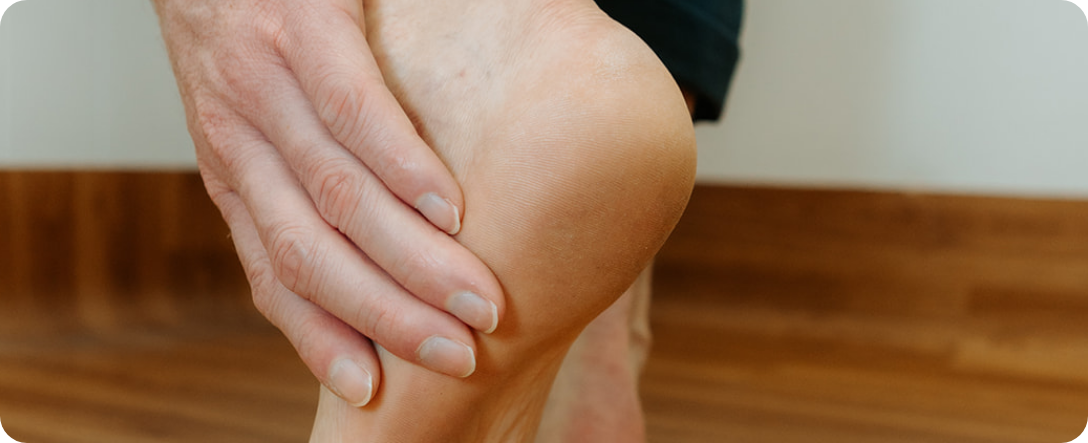Heel Pain Treatment

Heel Pain Treatment
Heel pain is a common issue that can significantly disrupt your daily activities and overall quality of life. At Podiatry Hub, we specialise in diagnosing and treating the underlying causes of heel pain, whether it’s due to plantar fasciitis, Achilles tendinopathy, heel spurs, or other conditions. Our expert podiatrists provide personalised care to help relieve your pain and restore your mobility.
Common Causes of Heel Pain
1. Plantar Fasciitis: The most common cause of heel pain, plantar fasciitis involves inflammation of the plantar fascia, the thick band of tissue connecting the heel to the toes. Pain often manifests as a stabbing sensation, especially in the morning or after long periods of rest.
2. Achilles Tendinopathy: This condition results from overuse or degeneration of the Achilles tendon, which connects the calf muscles to the heel bone. It causes pain and stiffness in the back of the heel, particularly after physical activity or periods of rest.
3. Heel Spurs: Heel spurs are bony growths on the underside of the heel bone that can form due to long-term stress on the foot muscles and ligaments. They can cause significant discomfort, especially when walking or standing for extended periods.
4. Bursitis: Inflammation of the bursae (fluid-filled sacs that cushion the joints) around the heel can lead to pain and discomfort, often aggravated by wearing tight shoes or excessive activity.
5. Tarsal Tunnel Syndrome: Similar to carpal tunnel in the wrist, this condition involves compression of the posterior tibial nerve along the inside of the ankle, which can cause pain that radiates to the heel.
Heel Pain Treatment Options
At Podiatry Hub, we offer tailored treatments to address the root cause of your heel pain. After a comprehensive assessment, our podiatrists will recommend the most suitable treatment plan for you. Here are some of our most effective approaches:
1. Rest and Footwear Advice
One of the simplest and most effective treatments for heel pain is rest. Reducing physical activity, especially high-impact activities like running, can help relieve strain on the affected area, giving your body time to heal. Alongside rest, proper footwear plays a critical role in preventing and managing heel pain. We offer personalised advice on selecting shoes that provide the right support and cushioning for your foot type. Supportive shoes with cushioned soles help distribute pressure evenly across the foot, reducing the strain on the heel and other areas prone to discomfort.
Additionally, replacing worn-out shoes and avoiding high heels or unsupportive footwear can prevent further irritation. In some cases, temporary use of heel cups or pads may be recommended to provide extra cushioning and protection.
2. Custom Orthotics
Orthotics, or custom-made shoe inserts, are an excellent solution for many heel pain conditions. At Podiatry Hub, we provide custom orthotics that are specifically designed for your unique foot structure and biomechanics. Orthotics work by redistributing pressure away from the painful areas of your foot, such as the heel or arch, and offering additional support where it’s needed most.
By correcting any imbalances in your gait (the way you walk) or foot mechanics, orthotics can help relieve stress on the plantar fascia or Achilles tendon, reducing pain and preventing the recurrence of heel issues. Unlike over-the-counter insoles, custom orthotics are tailored to fit your feet perfectly, offering long-term relief from conditions like plantar fasciitis, Achilles tendinopathy, and heel spurs.
3. Stretching and Strengthening Exercises
Stretching and strengthening exercises are key components in the treatment of heel pain, especially for conditions like plantar fasciitis and Achilles tendinopathy. Our podiatrists will guide you through a series of exercises designed to improve flexibility, strength, and stability in the muscles and tendons surrounding the heel and arch of your foot.
Plantar Fascia Stretching: Gentle stretches targeting the plantar fascia can help relieve tightness and improve mobility. This includes exercises such as rolling the foot over a tennis ball or stretching the arch with a towel.
Calf Stretches: Tight calf muscles can contribute to heel pain by increasing tension on the Achilles tendon and plantar fascia. Calf stretches help lengthen these muscles, reducing the stress on your heel.
Strengthening Exercises: Strengthening the muscles of the foot and lower leg can help support the arch and improve overall foot mechanics, preventing further strain on the heel. Exercises such as toe curls and resistance band workouts are particularly beneficial.
By consistently performing these exercises, patients can not only reduce their current pain but also prevent the recurrence of heel pain by strengthening the tissues and improving flexibility over time.
At Podiatry Hub, our goal is to provide effective, long-term relief from heel pain. With our tailored approach combining rest, custom orthotics, and targeted exercises, you can experience significant improvement and get back to your everyday activities. If you’re suffering from heel pain, don’t wait—schedule an appointment today and start your journey toward pain-free feet!
<–Nail Care, Corn & Callus Removal
Fungal Nail Treatment ->
